ML Aggarwal Circles Exe-15.1 Class 10 ICSE Maths Solutions. We Provide Step by Step Answer of Exe-15.1 Questions for Circles as council prescribe guideline for upcoming board exam. Visit official Website CISCE for detail information about ICSE Board Class-10.
ML Aggarwal Circles Exe-15.1 Class 10 ICSE Maths Solutions
| Board | ICSE |
| Subject | Maths |
| Class | 10th |
| Chapter-15 | Circles |
| Writer / Book | Understanding |
| Topics | Solutions of Exe-15.1 |
| Academic Session | 2024-2025 |
Circles Exe-15.1
ML Aggarwal Class 10 ICSE Maths Solutions
(Page 320)
Question 1. Using the given information, find the value of x in each of the following figures :

Answer :
(i) ∠ADB and ∠ACB are in the same segment.
∠ADB = ∠ACB = 50°
Now in ∆ADB,
∠DAB + X + ∠ADB = 180°
= 42° + x + 50° = 180°
= 92° + x = 180°
x = 180° – 92°
x = 88°
(ii) In the given figure we have
= 32° + 45° + x = 180°
= 77° + x = 180°
x = 103°
(iii) From the given number we have
∠BAD = ∠BCD
∠BAD = 20°
∠BCD = 20°
∠CEA = 90°
∠CED = 90°
Now in triangle CED,
∠CED + ∠BCD + ∠CDE = 180°
⇒ 90° + 20° + x = 180°
⇒ 110° + x = 180°
⇒ x = 180° – 110°
⇒ x = 70°
(iv) In ∆ABC
∠ABC + ∠ABC + ∠BAC = 180°
⇒ 69° + 31° + ∠BAC = 180°
⇒ ∠BAC = 180° – 100°
⇒ ∠BAC = 80°
Since, ∠BAC and ∠BAD are in the same
Segment.
∠BAD = x° = 80°
(v) Given ∠CPB = 120°, ∠ACP = 70°
To find, x° i,e., ∠PBD
Reflex ∠CPB = ∠BPO + ∠CPA
⇒ 120° = ∠BPD + ∠BPD
(BPD = CPA are vertically opposite ∠s)
⇒ 2∠BPD = 120°
⇒ ∠PBD = 120°/2 = 60°
Also ∠ACP and PBD are in the same segment
∠PBD + ∠ACP = 70°
Now, In ∆PBD
∠PBD + ∠PDB + ∠BPD = 180°
(sum of all ∠s in a triangle)
70° + x° + 60° = 180°
⇒ x = 180° – 130°
⇒ x = 50°
(vi) ∠DAB = ∠BCD
(Angles in the same segment of the circle)
∠DAB = 25° (∠BCD = 25° given)
In ∆DAP,
Ex. ∠CDA = ∠DAP + ∠DPA
⇒ x° = ∠DAB + ∠DPA
⇒ x° = 25° + 35°
⇒ x° = 60°
Circles Exe-15.1
ML Aggarwal Class 10 ICSE Maths Solutions
(Page 321)
Question 2. If O is the centre of the circle, find the value of x in each of the following figures (using the given information):

Answer :
(i) ∠ACB = ∠ADB
(Angles in the same segment of a circle)
But ∠ADB = x°
∠ABC = x°
Now in ∆ABC
∠CAB + ∠ABC + ∠ACB = 180°
⇒ 40° + 90° + x° = 180°
(AC is the diameter)
⇒ 130° + x° = 180°
⇒ x° = 180° – 130° = 50°
(ii) ∠ACD = ∠ABD
(angles in the same segment)
∠ACD = x°
Now in triangle OAC,
OA = OC
(radii of the same circle)

∠ACO = ∠AOC
(opposite angles of equal sides)
Therefore, x° = 62°
(iii) ∠AOB + ∠AOC + ∠BOC = 360°
(sum of angles at a point)
∠AOB + 80° + 130° = 360°
⇒ ∠AOB + 210° = 360°
⇒ ∠AOB = 360° – 210° = 150°
Now arc AB subtends ∠AOB at the center ∠ACB at the remaining part of the circle
∠AOB = 2 ∠ACB
⇒ ∠ACB = ½ ∠AOB = ½ × 150° = 75°
(iv) ∠ACB + ∠CBD = 180°
⇒ ∠ABC + 75° = 180°
⇒ ∠ABC = 180° – 75° = 105°
Now arc AC Subtends reflex ∠AOC at the center and ∠ ABC at the remaining part of the circle.
Reflex ∠AOC = 2 ∠ABC
= 2 × 105°
= 210°
(v) ∠AOC + ∠COB = 180°
⇒ 135° + ∠COB = 180°
⇒ ∠COB = 180° – 135° = 45°
Now arc BC Subtends reflex ∠COB at the center and ∠ CDB at the remaining part of the circle.
∠COB = 2 ∠CDB
⇒∠CDB = ½ ∠COB
= ½ × 45o = 45o/2 = 22 1/2o
(vi) Arc AB subtends ∠AOD at the center and ∠ACD at the remaining part of the Circle
∠AOD = 2 ∠ACB
⇒ ∠ACB = ½ ∠AOD = ½ × 70o = 35o
∵ ∠CMO = 90o
∴ ∠AMC = 90o
(∴∠AMC + ∠CMO = 180o)
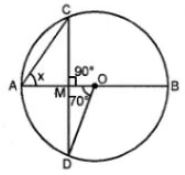
∠ACM + ∠AMC + ∠CAM = 180o
⇒ 35o + 90o + xo = 180o
⇒ 125o + xo = 180o
⇒ xo = 180 – 125o = 55o
Question 3.
(a) In the figure (i) given below, AD || BC. If ∠ACB = 35°. Find the measurement of ∠DBC.
(b) In the figure (ii) given below, it is given that O is the centre of the circle and ∠AOC = 130°. Find ∠ABC

Answer :
(a) Construction: Join AB
∠A = ∠C = 35° [∵ Alt angles]
⇒ ∠ABC = 35o
(b) ∠AOC + reflex ∠AOC = 360o
⇒ 130o + Reflex ∠AOC = 360o
⇒ Reflex ∠AOC = 360o – 130o = 230o
Now, arc BC Subtends reflex ∠AOC at the center and ∠ABC at the remaining part of the circle.
Reflex ∠AOC = 2 ∠ABC
⇒ ∠ABC =1/2 reflex ∠AOC
= ½ × 230o = 115o
Question 4
(a) In the figure (i) given below, calculate the values of x and y.
(b) In the figure (ii) given below, O is the centre of the circle. Calculate the values of x and y.

Answer :
(a) ABCD is a cyclic quadrilateral
∠B + ∠D = 180°
⇒ y + 40° + 45o = 180o
(y + 85o = 180o)
⇒ y = 180o – 85o = 95o
(∠ACB = ∠ADB)
⇒ xo = 40
(b) Arc ADC Subtends ∠AOC at the center and ∠ ABC at the remaining part of the circle
∠AOC = 2 ∠ABC
⇒ xo = 60o
Again, ABCD is a Cyclic quadrilateral
∠B + ∠D = 180o
(60o + yo = 180o)
⇒ y = 180o – 60o = 120o
Circles Exe-15.1
ML Aggarwal Class 10 ICSE Maths Solutions
(Page 322)
Question 5.
(a) In the figure (i) given below, M, A, B, N are points on a circle having centre O. AN and MB cut at Y. If ∠NYB = 50° and ∠YNB = 20°, find ∠MAN and the reflex angle MON.
(b) In the figure (ii) given below, O is the centre of the circle. If ∠AOB = 140° and ∠OAC = 50°, find
(i) ∠ACB
(ii) ∠OBC
(iii) ∠OAB
(iv) ∠CBA

Answer :
(a) ∠NYB = 50°, ∠YNB = 20°.

∠NYB + ∠YNB + ∠YBN = 180o
⇒ 50o + 20o + ∠YBN = 180o
⇒ ∠YBN + 70o = 180o
⇒ ∠YBN = 180o – 70o = 110o
But ∠MAN = ∠YBN
(Angles in the same segment)
⇒ ∠MAN = 110o
Major arc MN subtend reflex ∠MON at the
Centre and ∠MAN at the remaining part of the choice.
Reflex ∠MAN at the remaining part of the circle
Reflex ∠MON = 2 ∠MAN = 2×110o =220o
(b)
(i) ∠AOB + reflex ∠AOB = 360o
(Angles at the point)
⇒ 140o + reflex ∠AOB = 360o
⇒ Reflex ∠AOB = 360o – 140o = 220o
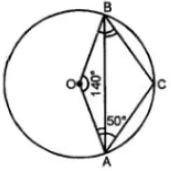
Now major arc AB subtends ∠AOB+ ∠OBC = 360o
⇒ 50o + 110o + 140o + ∠OBC =360°
⇒ 300o + ∠OBC = 360°
⇒ ∠300o + ∠OBC = 360°
⇒ ∠OBC = 360o – 300o
⇒ ∠OBC = 60o
(ii) In Quadrilateral, OACB
∠OAC + ∠ACB + ∠AOB + ∠OBC = 360o
⇒ 50o + 110o + 140o + ∠OBC = 360o
⇒ 300o + ∠OBC = 360o
⇒ ∠OBC = 360o – 300o
⇒ ∠OBC =60o
(iii) In ∆OAB,
OA = OB
(Radii of the same circle)
⇒ ∠OAB + ∠OBA = 180o
⇒ 2∠OAB = 180o – 140o = 40o
⇒ ∠OAB = 40o/2 = 20°
But, ∠OBC = 60o
∠CBA = ∠OBC – ∠OBA = 60o – 20o = 40o
Question 6.
(a) In the figure (i) given below, O is the centre of the circle and ∠PBA = 42°. Calculate the value of ∠PQB
(b) In the figure (ii) given below, AB is a diameter of the circle whose centre is O. Given that ∠ECD = ∠EDC = 32°, calculate
(i) ∠CEF
(ii) ∠COF.

Answer :
(a) In ∆APB,
∠APB = 90° (Angle in a semi-circle)
But ∠A + ∠APB + ∠ABP = 180° (Angles of a triangle)
⇒ ∠A + 90° + 42°= 180°
⇒ ∠A + 132° = 180°
⇒ ∠A = 180° – 132° = 48°
But ∠A = ∠PQB
(Angles in the same segment of a circle)
⇒ ∠PQB = 48o
(b)
(i) in ∆EDC,
(Exterior angle of a triangle is equal to the sum of its interior opposite angels)
(ii) arc CF subtends ∠COF at the center and
∠CDF at the remaining part of the circle
∠COF = 2∠CDF = 2∠CDE
= 2×32o = 2 ∠CDE
= 2×32o
= 64
Question 7.
(a) In the figure (i) given below, AB is a diameter of the circle APBR. APQ and RBQ are straight lines, ∠A = 35°, ∠Q = 25°. Find (i) ∠PRB (ii) ∠PBR (iii) ∠BPR.
(b) In the figure (ii) given below, it is given that ∠ABC = 40° and AD is a diameter of the circle. Calculate ∠DAC.

Answer :
(a) (i) ∠PRB = ∠BAP
(Angles in the same segment of the circle)
∴ ∠PRB = 35° (∵ ∠BAP = 35° given)
(ii) In ∆PRQ,
Ext. ∠APR = ∠PRQ + ∠PQR
= ∠PRB + ∠Q
= 35°+25° = 60°
But ∠APB = 90° (Angle in a semi circle)
∴ ∠BPR = ∠APB – ∠APR
= 90° -60° = 30°
(iii) ∠APR = ∠ABR
⇒ ∠ABR = 60°
In △PBQ,
Ext. ∠PBR = ∠Q + ∠BPQ
= 25° + 90° = 115°
(b) ∠B = ∠D (Angles in the same segment)
∴ ∠C = 40°
∠ACD = 90° (Angle in the semi circle)
Now in △ADC,
∠ACD + ∠D + ∠DAC = 180° (Angles in a triangle)
⇒ 90° + 40° + ∠DAC = 180°
⇒ 130° + ∠DAC = 180°
⇒ ∠DAC = 180° – 130° = 50°
Circles Exe-15.1
ML Aggarwal Class 10 ICSE Maths Solutions
(Page 323)
Question 8
(a) In the figure given below, P and Q are centers of two circles intersecting at B and C. ACD is a straight. line. Calculate the numerical value of x.

(b) In the figure given below, O is the circumcenter of triangle ABC in which AC = BC. Given that ∠ACB = 56°, calculate
(i)∠CAB
(ii)∠OAC

Answer :
Given that:
(a) Arc AB subtends ∠APB at the centre and ∠ACB at the remaining part of the circle
∠ACB = ½ ∠APB = ½ × 130o = 65o
But ∠ACB + ∠BCD = 180o (Linear Pair)
⇒ 65o + ∠BCD = 180o
⇒ ∠BCD = 180o – 65o = 115o
Major arc BD subtends reflex ∠BQD at the
Centre and ∠BCD at the remaining part of the circle reflex ∠BQD = 2∠BCD
= 2×115o = 230°
But reflex ∠BQD + x = 360o (Angles at a point)
⇒ 230o + x = 360o
⇒ x = 360o – 230o = 130o
(b) Join OC

In ∆ABC,
AC = BC
∠A = ∠B
But ∠A + ∠B + ∠C = 180o
⇒ ∠A + ∠A + 56° = 180°
⇒ 2∠A = 180o – 56° = 124o
⇒ ∠A = 124/2 = 62o or ∠CAB = 62°
OC is the radius of the circle. OC bisects ∠ACB.
∠OCA = ½∠ACB = ½×56o = 28o
Now in ∆OAC
OA = OC (radii of the same Circle)
∠OAC = ∠OCA = 28o
Question 9.
(a) In the figure (i) given below, chord ED is parallel to the diameter AC of the circle. Given ∠CBE = 65°, calculate ∠DEC.

(b) In the figure (ii) given below, C is a point on the minor arc AB of the circle with centre O. Given ∠ACB = p°, ∠AOB = q°, express q in terms of p. Calculate p if OACB is a parallelogram.
Answer :
(a) ∠CBE = ∠CAE
(Angle in the same segment of a circle)
⇒ ∠CAE = 65°
∠AEC = 90° (Angle in a semi circle)
Now in ∆AEC
∠AEC + ∠CAE + ∠ACE = 180° (Angle of a triangle)
⇒ 90°+ 65° +∠ACE = 180°
so ⇒ 155° + ∠ACE = 180°
hence ⇒ ∠ACE = 180° – 155° – 25°
∵AC || ED (given)
∴∠ACE = ∠DEC (alternate angles)
∴∠DEC = 25°

Question 10.
(a) In the figure (i) given below, straight lines AB and CD pass through the centre O of a circle. If ∠OCE = 40° and ∠AOD = 75°, find the number of degrees in :
(i) ∠CDE
(ii) ∠OBE.
(b) In the figure (ii) given below, I is the incentre of ∆ABC. AI produced meets the circumcircle of ∆ABC at D. Given that ∠ABC = 55° and ∠ACB = 65°, calculate
(i) ∠BCD
(ii) ∠CBD
(iii) ∠DCI
(iv) ∠BIC.

Answer :
(a) (i) ∠CED = 90° (Angle in semi-circle)
In ∆CED
∠CED + ∠CDE + ∠DCE = 180°
so ⇒ 90° +∠CDE + 40° = 180°
therefore ⇒ 130° + ∠CDE = 180°
hence ⇒ ∠CDE = 180° – 130° = 50°



Question 11. O is the circumcenter of the triangle ABC and D is mid-point of the base BC. Prove that ∠BOD = ∠A.
Answer :
In the given figure, O is the centre of circumcenter of ∆ABC.
D is mid-point of BC. BO, CO and OD are joined.

Circles Exe-15.1
ML Aggarwal Class 10 ICSE Maths Solutions
(Page 324)
Question 12. In the adjoining figure, AB and CD are equal chords. AD and BC intersect at E. Prove that AE = CE and BE = DE.

Answer :
In the given figure, AB and CD are two equal chords
AD and BC intersect each other at E.
To prove : AE = CE and BE = DE
Proof:
In ∆AEB and ∆CED
AB = CD (given)
∠A = ∠C (angles in the same segment)
∠B = ∠D (angles in the same segment)
∴ ∆AEB ≅ ∆CED (ASA axiom)
∴ AE = CE and BE = DE (c.p.c.t.)
Question 13.
(a) In the figure (i) given below, AB is a diameter of a circle with centre O. AC and BD are perpendiculars on a line PQ. BD meets the circle at E. Prove that AC = ED.
(b) In the figure (ii) given below, O is the centre of a circle. Chord CD is parallel to the diameter AB. If ∠ABC = 25°, calculate ∠CED.

Answer :
(a) Given: AB is the diameter of a circle with centre O.
AC and BD are perpendiculars on a line PQ,
such that BD meets the circle at E.



Question 14. In the adjoining figure, O is the centre of the given circle and OABC is a parallelogram. BC is produced to meet the circle at D.
Prove that ∠ABC = 2 ∠OAD.

Answer :
Given: In the figure,
OABC is a || gm and O is the centre of the circle.
BC is produced to meet the circle at D.
To Prove : ∠ABC = 2∠OAD.
Construction: Join AD.

Question 15.
(a) In the figure (i) given below, P is the point of intersection of the chords BC and AQ such that AB = AP. Prove that CP = CQ.

(b) In the figure (i) given below, AB = AC = CD, ∠ADC = 38°. Calculate :
(i) ∠ABC (ii) ∠BEC.

Answer :
(a) Given:
Two chords AQ and BC intersect each other at P
inside the circle. AB and CQ are joined and AB = AP.
To Prove : CP = CQ
Construction : Join AC.
Proof: In ∆ABP and ∆CQP
∴ ∠B = ∠Q

Circles Exe-15.1
ML Aggarwal Class 10 ICSE Maths Solutions
(Page 325)
Question 16.
(a) In the figure (i) given below, CP bisects ∠ACB. Prove that DP bisects ∠ADB.
(b) In the figure (ii) given below, BD bisects ∠ABC. Prove that AB/BD=BE/BC

Answer :
(a)Given: In the figure, CP is the bisector of
∠ACB meeting the circle at P.
PD is joined


Question 17.
(a) In the figure (ii) given below, chords AB and CD of a circle intersect at E.
(i) Prove that triangles ADE and CBE are similar.
(ii) Given DC =12 cm, DE = 4 cm and AE = 16 cm, calculate the length of BE.

(b) In the figure (ii) given below, AB and CD are two intersecting chords of a circle. Name two triangles which are similar. Hence, calculate CP given that AP = 6cm, PB = 4 cm, and CD = 14 cm (PC > PD).
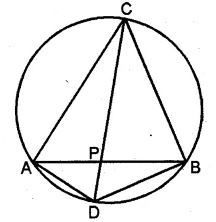
Answer :
(a) Given: Two chords AB and CD intersect each other
at E inside the circle.




Question 18. In the adjoining figure, AE and BC intersect each other at point D. If ∠CDE = 90°, AB = 5 cm, BD = 4 cm and CD = 9 cm, find DE. (2008)

Answer :
In the figure, AE and BC intersect each other at D.
AB is joined.


Question 19.
(a) In the figure (i) given below, PR is a diameter of the circle, PQ = 7 cm, QR = 6 cm and RS = 2 cm. Calculate the perimeter of the cyclic quadrilateral PQRS.
(b) In the figure (ii) given below, the diagonals of a cyclic quadrilateral ABCD intersect in P and the area of the triangle APB is 24 cm². If AB = 8 cm and CD = 5 cm, calculate the area of ∆DPC.

Answer :
(a) PR is the diameter of the circle
PQ = 7 cm, QR = 6 cm, RS = 2 cm.


Circles Exe-15.1
ML Aggarwal Class 10 ICSE Maths Solutions
(Page 326)
Question 20.
(a) In the figure (i) given below, QPX is the bisector of ∠YXZ of the triangle XYZ. Prove that XY : XQ = XP : XZ,
(b) In the figure (ii) given below, chords BA and DC of a circle meet at P. Prove that:
(i) ∠PAD = ∠PCB
(ii) PA. PB = PC . PD.
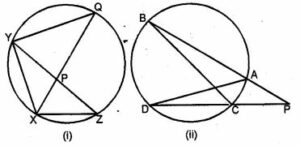
Answer :
(a) Given: ∆XYZ is inscribed in a circle.
Bisector of ∠YXZ meets the circle at Q.
QY is joined.
To Prove : XY : XQ = XP : XZ


— : End of ML Aggarwal Circles Exe-15.1 Class 10 ICSE Maths Solutions : –
Return to: ML Aggarwal Solutions for ICSE Class-10
Thanks
Please Share with Your Friends
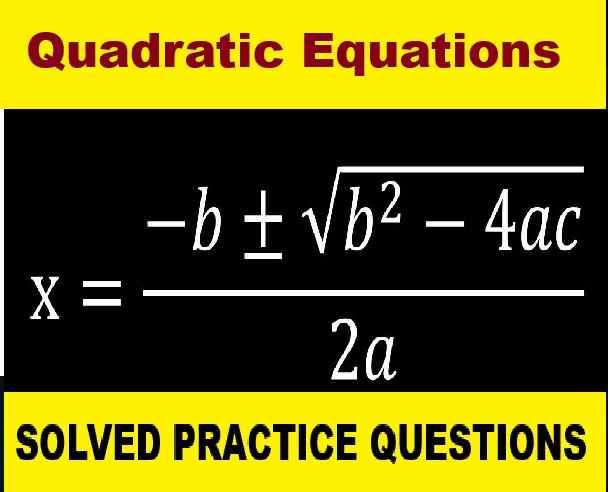


wow
thanks
are you soumya arora?
Where are the solutions for 15.2 and 15.3?
would be update in latest 2022-23 session
Can’t get
Jid
Amazing